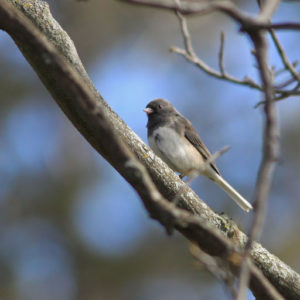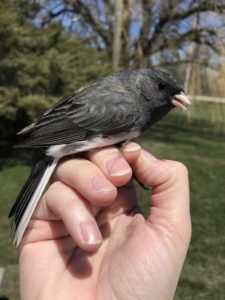I was driving to Fern Hill School’s Oakville campus first thing this morning. The steady snow had slowed traffic (the usual 50 minute drive took almost an hour and a half) so I decided to cut up Bronte Road and head east along Hwy.5/Dundas Street. Man, I can’t get over all the development that is going on!! New houses and condos all along the route. And I found myself trying to roughly calculate how much wildlife habitat was being lost. It’s a depressing exercise…..
There isn’t a lot of wild area at Fern Hill and much of what is there (e.g., the wonderful Bobolink field just next door) is also slated for development – it’s “progress”, right?
The conditions didn’t warrant opening any nets but I did bait a few traps…and by the end of the day I had banded 7 birds (5 Mourning Doves; 2 Dark-eyed Juncos) and handled 8 retraps (1 Chickadee; 5 Juncos; 2 Northern Cardinals). The retraps here I find quite interesting (well…..all retraps actually…): In the last couple of days we’ve had 6 juncos that have returned from at least one nesting event in the far north: 1 was banded in December, 2017; 2 were banded in December, 2018; 3 in January/February 2020. The little wild area of shrubs, small trees, goldenrod, and, of course, consistently-filled feeders brings them back time after time. What would they do if this little wild spot was “developed”?
If each household made a point of maintaining a “wild” space in their yard would multiple community household wild spaces make a difference? I tend to think they would. Just areas where you let native plants grow up – from wildflowers to shrubs and trees. With large-scale building going on all around us, I hope this could make a positive difference in maintaining wild bird populations.
Rick


